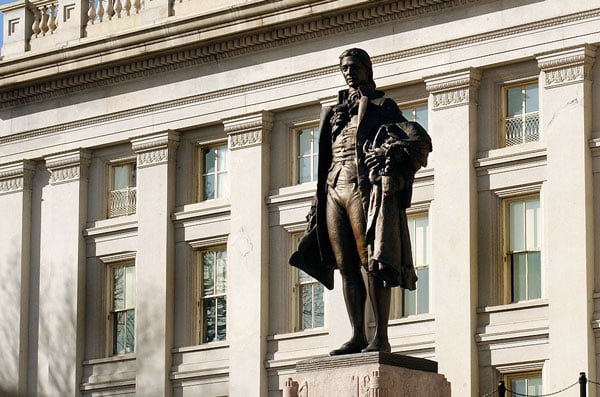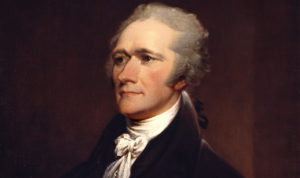In mid-June, the U.S. Treasury Department announced a scheme by which it will either displace or demote Alexander Hamilton’s image on the $10 bill, in favor of a yet-to-be named woman chosen by some unspecified democratic poll. The woman will be named later this year, but the final change is scheduled for 2020, to mark the centennial of American women getting the right to vote in U.S. elections (via the 19th Amendment to the U.S. Constitution). The Treasury claims that the $10 bill is due for a security upgrade anyway (to deter counterfeiting), so apparently it feels this is as good a time as any to jettison the nation’s first and greatest Treasury secretary.1
This is an injustice to Alexander Hamilton, a derogation of the U.S. founding, and yet another example of “identity politics.”
Hamilton is arguably the greatest of all the great Founding Fathers of the United States, the most morally exceptional nation in human history—that is, the most individualist, freedom-loving, and rights-respecting nation. Pushers of “identity politics” disdain such values and principles, and insist that people be judged not by the content of their character, the solidity of their logic, or the liberty in their politics (things over which they have control) but instead by their race, ethnicity, or gender (things about which they lack choice).
I regard Hamilton objectively as the greatest of the Founders because he alone contributed in each of the five phases necessary to create the United States of America: the moral-ideological case for political independence (1774–1775), the formal declaration of independence (1776), the Revolutionary War (1775–1783), the creation and ratification of the Constitution (1787–1788), and the practical implementation and administration of the new federal government under President Washington’s two terms (1789–1799). Other Founders were important in some of these five phases but not in all of them.
Having left a tumultuous Caribbean upbringing in search of a better life in America, a brilliant and ambitious young Hamilton enrolled at Kings College (now Columbia University) at age fifteen, in 1772. Revolutionary spirit and action were growing, with the Boston Massacre (1770), Boston Tea Party (1773), and the battle at Lexington-Concord (1775). At age seventeen, Hamilton addressed a crowd in the Fields (now City Hall Park) and called for a principled revolution. He then wrote widely read pamphlets on the issue, during 1774 and 1775, which included a consistent case for rights:
All men have one common original, they participate in one common nature, and consequently have one common right. No reason can be assigned why one man should exercise any power over his fellow creatures more than another, unless they voluntarily vest him with it.2
Unlike certain other Founders, Hamilton held that all men (blacks and women included) were created equal, by the fact of uniform human nature, and thus that all deserved equal political rights and equal protection under the law. And, as an abolitionist, he helped the New York Manumission Society (founded in 1785) pressure the state into ending slavery in 1799.3
In wartime, Hamilton first trained troops but soon was hired by General Washington as a main confidant and aide-de-camp. Hamilton helped manage the army, solicited loans, secured supplies, and even contributed heroically to the final, victorious battle (and Britain’s surrender) at Yorktown in 1781. In his spare time he studied economics and law, corresponded with older, experienced political leaders, and devised concrete plans to improve American governance and public finances in peacetime.
After the war’s end in 1783, nothing was inevitable about an ultimate union among the original thirteen states. Many citizens of Virginia referred to that state as their “country” and wanted no part of any wider political union. The states, no longer facing a common enemy in Britain, increasingly fought among themselves over bad debts, depreciating monies, trade barriers, and fugitive slaves. Overall, the nation was bankrupt and in political-economic disarray.
Hamilton, more than anyone else, recognized the need for a federal government that could instill an efficient uniformity, in matters both military and monetary, while reducing the excessive and arbitrary powers of the thirteen states. Hamilton, more than anyone else—while facing hostile opposition from the Jeffersonian “anti-Federalists”—encouraged leaders to make a new Constitution at the 1787 convention. He then fostered ratification of that charter by writing fifty-one of the eighty-five essays known as the Federalist Papers, which today remain the most profound and impactful political essays ever penned by Americans. Cited more than any other source by the U.S. Supreme Court, the essays include Hamilton’s doctrine of “judicial review,” requiring objective, legal reversals of rights-violating laws—a doctrine the court tragically abandoned long ago.4
The American “divorce” from Britain in 1776 didn’t mandate a subsequent “marriage” among the thirteen American states, as was attained by 1789. A war had to be won, a case made, opposition rebutted, a frame built, a charter ratified, officials elected, a government administered, public debts paid, money fixed, and an economy revived. More than anyone, Hamilton envisioned this sequence, then helped make it happen. Hamilton put the “U” in U.S.A.

Statue of Hamilton (1757-1804) by James Earle Fraser at U.S. Treasury Building in Washington, D.C. Photo by Karen Nutini.
One of his biographers, Ron Chernow, describes Hamilton as “the supreme double threat among the founding fathers, at once thinker and doer, sparkling theoretician and masterful executive.” “No other founder,” he contends, “articulated such a clear and prescient vision of America’s future political, military, and economic strength or crafted such ingenious mechanisms to bind the nation together.”5
Hamilton wanted harmony and unity, whereas his opponents preferred animosity and division—and, later, even secession. Many southern Founders, the slave-owning plantation aristocrats, claimed that only rural, agrarian life was productive and virtuous, whereas cities, manufacturers, merchants, and financiers were parasitical and vice-ridden. Jefferson’s Notes on the State of Virginia asserted that “those who labor in the earth are the chosen people of God,” that in them alone God “made his peculiar deposit for substantial and genuine virtue.” He further claimed that we must “never wish to see our citizens occupied at a work-bench, or twirling a distaff.” Instead, he said, “for the general operations of manufacture, let our work-shops remain in Europe.”6
Hamilton alone would make the cosmopolitan case—in his Report on Manufacturers (1791)—that each of the economic sectors is productive, mutually supportive, and virtuous. He alone foresaw a harmony of inter-sectoral self-interest and thoroughly rejected what is now called “class warfare.” He saw that benevolence and benefit alike flowed from a diverse economy: “To cherish and stimulate the activity of the human mind,” he wrote, “by multiplying the objects of enterprise, is not among the least considerable of the expedients by which the wealth of a nation may be promoted.”
Every new scene which is opened to the busy nature of man to rouse and exert itself is the addition of a new energy to the general stock of effort. The spirit of enterprise, useful and prolific as it is, must necessarily be contracted or expanded in proportion to the simplicity or variety of the occupations and productions which are to be found in a Society.7
Hamilton is best known for his financial brilliance, exhibited especially as the first U.S. Treasury secretary, 1789–1795. In a few short years, he authored comprehensive plans of fiscal and monetary reform that, once approved by Congress and enacted by his office, transformed the federal government from a debt-defaulting bankrupt, issuing worthless paper money, into an honorable debt-payer, practicing fiscal rectitude while issuing a gold-silver based dollar.
It wasn’t Hamilton’s fault that the Revolutionary War entailed massive deficit spending and excessive public debts; nor was he some proto-Keynesian claiming that such a fiscal mix would “stimulate” the economy. No one likes advocating (or paying) high taxes in wartime; hence the debt. But instead of demanding reckless postwar defaults, as did his opponents, Hamilton defended the sanctity of contract and the honor of paying one’s debts. He arranged to properly service all federal debts and to relieve the states of their own debt burdens, so each could start with a clean slate and not resume interstate fights over latent imbalances of money and credit.
U.S. public debt was initially 40 percent of GDP (in 1790), but Hamilton’s prudent management radically halved the burden to just 20 percent of GDP by the time he left office (in 1795). In 1790, Hamilton warned Congress against the public debt again becoming excessive: “So far from acceding to the position that ‘public debts are public benefits,’ a position inviting to prodigality, and liable to dangerous abuse,” he wrote, Congress should codify “as a fundamental maxim, in the system of the public credit of the United States, that the creation of debt should always be accompanied with the means of extinguishment.” Hamilton advised steady repayments so that in a decade or so “the whole of the debt shall be discharged.”8 In 1795, he feared that were America to become more democratic, it would accumulate excessive public debt: “There is a general propensity in those who administer the affairs of government,” he warned, “to shift off the burden [of spending] from the present to a future day—a propensity which may be expected to be strong in proportion as the form of the state is popular.”9
Hamilton’s financial reforms also fostered nationwide banking and uniform tax collection via the Bank of the United States (chartered from 1791 to 1811). This was no “central bank,” as some now claim. Privately owned, it issued gold-and-silver-convertible money and lent little to the federal government; no such prudential features describe today’s politicized central banks. Hamilton arranged specifically for the bank to be apolitical, the opposite of what the Fed has been for years. “To attach full confidence to an institution of this nature,” he wrote, “an essential ingredient in its structure” is that it “be under a private not a public direction, under the guidance of individual interest, not of public policy,” never “liable to being too much influenced by public necessity,” because “suspicion of this would most likely be a canker that would continually corrode the vitals of the credit of the Bank.” If ever “the credit of the Bank be at the disposal of the government,” there would be a “calamitous abuse of it.”10 Hamilton made sure that didn’t happen; the bank was a success precisely because, unlike today’s central banks, it was privately owned and monetarily sound.
To those who bother to learn about or convey Hamilton’s indispensable contributions to the founding of the United States and to its legal-financial-economic foundations,11 it is inexplicable why anyone would seek to derogate his name, his reputation, or his image—least of all the U.S. Treasury Department. If efforts to remove Hamilton from U.S. currency betray an ignorance of who he was and what he did, that’s bad enough; if instead the efforts are made despite knowledge of Hamilton’s character and accomplishments, that’s morally obscene. Such an assault on such a great man is an instance of hatred of the good for being the good—hatred of Hamilton for his virtues: that he extols and defends genuine rights instead of mere public opinion, color-blindness instead of racism, a law-respecting republic instead of a mob-ruling democracy, capitalism instead of pastoralism, gold money instead of fiat paper, and debt-paying instead of debt-defaulting.
Hamilton was prescient when writing, in his final letter, that “our real Disease” is “democracy.”12 Perhaps this disease has advanced so far in our ever-more populist culture and political system that America cannot or will not interpret or honor Alexander Hamilton as the great thinker and statesmen he was. If so, these truly are tragic times.
To object to this proposed injustice, and to register your knowledge that Hamilton should remain on the $10 bill, visit the websites of the Treasury and The Alexander Hamilton Awareness Society (which provides links to several petitions), and speak your mind.
Endnotes
1. For details, see https://thenew10.treasury.gov/.
2. Alexander Hamilton, “A Full Vindication of the Measures of the Congress” (December 15, 1774), at Founders Online, National Archives (http://founders.archives.gov/documents/Hamilton/01-01-02-0054). Source: The Papers of Alexander Hamilton, vol. 1, 1768–1778, edited by Harold C. Syrett (New York: Columbia University Press, 1961), pp. 45–78.
3. Michael D. Chan, “Alexander Hamilton on Slavery,” The Review of Politics, vol. 66, no. 2 (Spring 2004), pp. 207–31.
4. The doctrine is explicated by Hamilton in Federalist Paper #78 (June 14, 1788). He writes: “The courts of justice are to be considered as the bulwarks of a limited Constitution against legislative encroachments.” See http://www.constitution.org/fed/federa78.htm.
5. Ron Chernow, Alexander Hamilton (New York: Penguin Press, 2004), p. 4. See also this book reviewed in The Objective Standard, Fall 2012, vol. 7, no. 3.
6. Thomas Jefferson, Notes on the State of Virginia (1781–1783). See http://xroads.virginia.edu/~hyper/JEFFERSON/ch19.html.
7. Alexander Hamilton, “Final Version of the Report on the Subject of Manufactures (December 5, 1791), at Founders Online, National Archives (http://founders.archives.gov/documents/Hamilton/01-10-02-0001-0007). Source: The Papers of Alexander Hamilton, vol. 10, December 1791–January 1792, edited by Harold C. Syrett (New York: Columbia University Press, 1966), pp. 230–340.
8. Alexander Hamilton, “Report Relative to a Provision for the Support of Public Credit” (January 9, 1790), at Founders Online, National Archives (http://founders.archives.gov/documents/Hamilton/01-06-02-0076-0002-0001). Source: The Papers of Alexander Hamilton, vol. 6, December 1789–August 1790, edited by Harold C. Syrett (New York: Columbia University Press, 1962), pp. 65–110.
9. Alexander Hamilton, “Report on a Plan for the Further Support of Public Credit” (January 16, 1795), at Founders Online, National Archives (http://founders.archives.gov/documents/Hamilton/01-18-02-0052-0002). Source: The Papers of Alexander Hamilton, vol. 18, January 1795–July 1795, edited by Harold C. Syrett (New York: Columbia University Press, 1973), pp. 56–129.
10. Alexander Hamilton, “Final Version of the Second Report on the Further Provision Necessary for Establishing Public Credit (Report on a National Bank)” (December 13, 1790), at Founders Online, National Archives (http://founders.archives.gov/documents/Hamilton/01-07-02-0229-0003). Source: The Papers of Alexander Hamilton, vol. 7, September 1790–January 1791, edited by Harold C. Syrett (New York: Columbia University Press, 1963), pp. 305–42.
11. For a good example, see the Alexander Hamilton Awareness Society (http://www.the-aha-society.com/).
12. Letter “From Alexander Hamilton to Theodore Sedgwick” (July 10, 1804), at Founders Online, National Archives (http://founders.archives.gov/documents/Hamilton/01-26-02-0001-0264). Source: The Papers of Alexander Hamilton, vol. 26, 1 May 1802–23 October 1804, Additional Documents 1774–1799, Addenda and Errata, edited by Harold C. Syrett (New York: Columbia University Press, 1979), pp. 309–11.
Related:
- Review: Alexander Hamilton, by Ron Chernow
- Celebrating Alexander Hamilton’s Achievements on His Birthday















